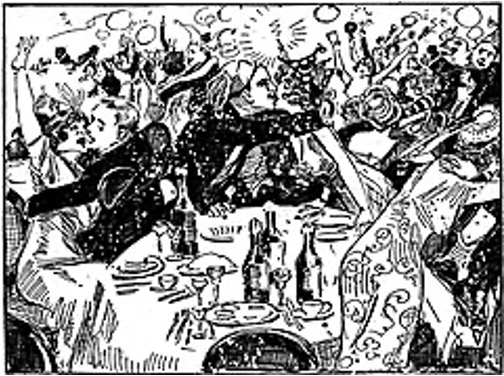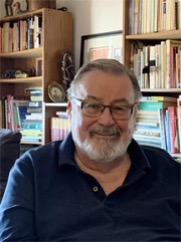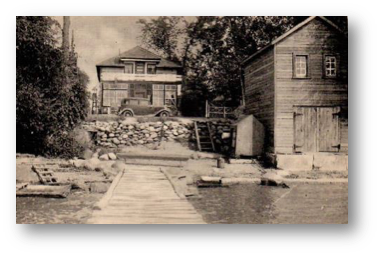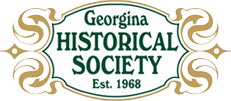Click to Download the PDF
Download the Word Doc
President’s Message
A fresh new year is upon us, and as the Georgina Historical Society enters its fiftieth year as a registered non-profit organization, and its fifty-sixth year as a historical society, we must be proud of our accomplishments. Always an active part of the community, the society was instrumental in creating the Georgina Pioneer Village and still maintains a presence there, in co-operation with the Town of Georgina. We have also kept the amazing history of Georgina, the Municipality of the Town of Sutton, and North Gwillimbury alive with our monthly newsletters and general meetings. We also cannot forget the villages that make up the Town of Georgina, from Udora to Medina, Ravenshoe to Island Grove, each and every community adding to our history. And foremost are the people, both working class and aristocracy, that created this wonderful community.
As more families move into Georgina, our local history is becoming more important than ever. The Town of Georgina boasts over 200 years of incredible history, and with railways, steamboats, Ontario’s first cottage country, and so many other aspects, our history is unique. If you have any ideas on how to improve your society, or how to increase our presence in the community, please come forward, we’d love to hear them.
Also, I want to thank our long-term members and new members alike for supporting us, and please don’t forget that we rely on dues and donations to keep operating. 2024 should be another great year!
Paul Brady, President
Origins of New Year’s Celebrations
The concept of New Year’s celebrations originated in ancient Mesopotamia around 2000 BC. The Romans later dedicated New Year’s Day to Janus, the god of beginnings (the month of January is also named after this deity). In 46 BC, Julius Caesar created the Julian calendar, of which January 1 is the first day. After his murder, the Romans deified Julius Caesar on New Year’s Day, 42 BC.
Early European pagans celebrated New Year’s Day by exchanging gifts. Most western European countries adopted January 1 as New Year’s Day once Pope Gregory III introduced the Gregorian calendar, a refinement of the Julian calendar, in 1582. In Christendom, New Year’s Day was celebrated as part of the Feast of the Circumcision of Christ.
New Year’s Day was traditionally celebrated as a religious feast. Since the late 1800s, it has also been popular to celebrate New Year’s Eve, December 31, with fireworks and festivities. Outside of religious contexts, New Year’s Eve/New Year’s Day began to represent a celebration of the past year and excitement for the start of a new year. In the latter part of the nineteenth century extravagant New Year’s Eve parties were thrown by the nouveau riche Americans of the Gilded Age. While the tradition of drinking champagne on New Year’s Eve most likely began in France, the custom was popularized by the American wealthy in the second half of the 19th century.

Left:- Fanciful sketch by reporter and artist Marguerite Martyn of a New Year’s Eve celebration, from the St. Louis Post-Dispatch of 4 January 1914.
Many cultures around the world celebrate winter and New Year’s festivities apart from January 1 and December 31 celebrations. For example, the Chinese New Year takes place in late January or early February. In Quebec, since it’s beginnings as a French colony, New France’s inhabitants made a tradition of gathering before Lent. From the end of January until mid-February, they celebrated with food and drink. In 1894, a large winter carnival was held in Quebec City. And the Carnaval de Quebec remains an annual tradition to this day.
We’ve been celebrating New Year’s for more than 2,000 years. Today, it’s entirely secular, an evening of partying. But until recently, the festivities were driven by spiritual significance rather than merely ringing in a new calendar. The importance of New Year’s dates to Roman times, when it was a holy day on which it was customary to exchange gifts. Early Christians assumed the pagan holy day and adapted it to their own tradition as the Feast of the Circumcision, the day on which the infant Jesus was circumcised according to Jewish custom on the eighth day after his birth. As a result, New Year’s continued to be a day of great significance and a time for giving gifts through the Middle Ages, especially to kings and nobles. Because Christmas is a whole season, not just a single day, these gifts were still referred to as Christmas presents. Even as late as the 19th century, New Year’s was the day of gift giving in much of England, Canada, and the United States. Indeed, giving presents of New Year’s was so commonplace that, throughout the 1800s, the poem, ’Twas the Night Before Christmas, was often amended to read as if the events took place on New Year’s Eve, with St. Nick exclaiming, “A happy New Year’s to all and to all a good night,” as he rode out of sight. Sometimes these gifts were not given by the Jolly Old Elf, but by Father Time, Baby New Year, or even Mother New Year.
In the present day, with most countries now using the Gregorian calendar as their civil calendar, January 1st according to the Gregorian calendar is among the most celebrated of public holidays in the world, often observed with fireworks at the stroke of midnight following New Year’s Eve as the new year starts in each time zone. Other global New Year’s Day traditions include making New Year’s resolutions and calling one’s friends and family.
The first of January represents the fresh start of a new year after a period of remembrance of the passing year, including on radio, television, and in newspapers, which starts in early December in countries around the world. Publications have year-end articles that review the changes during the previous year. There are also articles on planned or expected changes in the coming year.
Traditionally a religious feast, since the 1900s it also become an occasion to celebrate the night of 31 December—New Year’s Eve—with parties, public celebrations (often involving fireworks shows) and other traditions focused on the impending arrival of midnight and the new year. In the Gregorian calendar, New Year’s Eve, also known as Old Year’s Day, is the evening or the entire day of the last day of the year, 31 December. Some Christians attend a watchnight service. The celebrations generally go on past midnight into New Year’s Day, 1 January.
The Line Islands (part of Kiribati), Samoa and Tonga, in the Pacific Ocean, are the first places to welcome the New Year, while American Samoa, Baker Island and Howland Island (part of the United States Minor Outlying Islands) are among the last; the first large city to celebrate is Auckland, New Zealand.
Many of our earliest New Year’s traditions were brought into Canada by early pioneers from the British Isles, the United States, and Europe. The most prominent New Year’s Eve (Old Year’s Night) celebration today in England is that of Central London, where the arrival of midnight is greeted with the chimes of Big Ben. In recent years, a major fireworks display has also been held, with fireworks launched from the nearby London Eye Ferris wheel. In Scotland, New Year’s (Hogmanay) is celebrated with several different customs, such as First-Footing, which involves friends or family members going to each other’s houses with a gift of whisky and sometimes a lump of coal. The Welsh tradition of giving gifts and money on New Year’s Day (Calennig) is an ancient custom that survives in modern-day Wales, though nowadays it is now customary to give bread and cheese. Thousands of Welsh citizens descend every year on Cardiff to enjoy live music, catering, ice-skating, funfairs, and fireworks.
New Year’s Eve traditions and celebrations in Canada vary regionally, but are typically similar to those in the United States, with a focus on social gatherings and public celebrations (such as concerts, dancing, galas, and fireworks displays). Celebrations in the first half of the nineteenth century described in diaries and journals reveal activities which are not unlike those we engage in today as we celebrate The New Year. People came together to socialize and party then too. Dances, fetes, and other gatherings are mentioned by Anne Langdon in A Gentlewoman in Upper Canada, by Mary O’Brien in her journals, and Elizabeth Simcoe in her diary.
Catherine Parr-Trail in her Winter Studies and Summer Rambles notes that ”…they have here in Toronto gatherings that were held where the custom was to come and give congratulations on the first day of the New Year” …a tradition she’d observed in parts of Europe and the United States. It was a “duty” that must be observed despite the weather and biting temperature that had to be endured…a custom she thought “does not apparently harmonize with the manners of the people” and “ has been borrowed from the French inhabitants of Lower Canada.” She also notes that New Years and winter in particular, was a “time for visiting, sleighing excursions, for all intercourse of business and friendship, for balls in town, and dances in farmhouses, and courtships and marriages, and prayer meetings and assignations of all sorts.”
Sources:
https://www.astralinternet.com/en/miscellaneous/the-history-of-new-years-celebrations/
https://www.newmarkettoday.ca/local-news/new-years-wasnt-always-a-party-holiday-8042123
https://en.wikipedia.org/wiki/New_Year%27s_Eve
Journals of Mary O’Brien 1828-1838, pp.30-31 and 222-223.
Anne Langdon: A Gentlewoman in Upper Canada, pp. 72-75 and 142-143.
Catherine Parr-Traill: Winter Studies & Summer Rambles vol I pp20-22
Diary of Elizabeth Simcoe
Terry Carter: November 8th, 1935 – December 18th , 2023
By Robert Holden

It is with sadness that we mark the passing of Newmarket’s Terry Carter, a man known as much for his kindness as for contributions to Newmarket, and his extensive knowledge of that town’s history as well as that of Northern York Region. Robert Terence Carter died peacefully on December, 18, 2023 at the age of 88 at Margaret Bahen Hospice, where he had been for a day after a month-long hospital stay.
Daughter Jenn Dennis described her dad as a pillar of the community, a view shared by many others. “He was definitely the kindest man I ever met. He was honestly a pretty shy guy. He was quiet but always there for you, you know? Just strong and quiet,” she said. “I loved to sit and listen to his stories, his history stories. He was always telling me about early settlers from Newmarket and their trials and tribulations. It was nice to sit and listen to his stories.”
“Carter’s death is a great loss to Newmarket,” said Mayor John Taylor. “Terry was a fixture in the town of Newmarket in the best way possible. For decades, Terry contributed to the town of Newmarket through his involvement in the Chamber of Commerce, his local journalism and through his historical writings,” he said. “Terry’s locally famous ‘Stories of Newmarket’ is our source of the history of Newmarket. Terry was our source of history and now he is an important part of that history. His stories, humour and smiles will be missed by many.”
For me he will always be my ‘Mr. Newmarket’ and it was a privilege to have had him in my life as my friend. I will miss him greatly. Raised in Newmarket, Terry was the editor of The Newmarket Era from 1968 to 1985, and following a tradition initiated by Erastus Jackson, the paper’s first editor, he wrote a weekly history column for the newspaper. Renowned for sharing his knowledge of the town’s history, Terry was a mentor to many, including yours truly.
First introduced to Terry in 1973 by Lisa Lo, Newmarket’s Librarian at that time, I was engaged in historical research for my honours thesis at York. Appalled at the paucity of organized local historical resources available then, I discovered in Terry a kindred spirit and learned he’d been collecting numerous local historical resources as grist for the mill in his numerous pieces written for the Newmarket Era. In 1974, together we founded the Newmarket Historical Committee, a Committee of Newmarket Council, with Terry as its first Chairman while I was its Vice-chairman. The following year the roles were reversed and after that the chair passed on to Elman Campbell. Eventually the Committee evolved into the Newmarket Historical Society and ceased to remain a Committee of Council…it was felt it needed to separate from the Town as there would be a time when the Town’s interests would conflict with the aims and purposes set out originally for the Committee.
Terry’s love of Newmarket’s history shone through in his book, Newmarket: The Heart of York Region. Many of his history pieces touched on Georgina and East Gwillimbury, especially those on the Sharon Temple, the Rebellion of 1837, and the Metropolitan Railway that ran into Sutton. Terry also served as president of the Sharon Temple Museum Society in the early 1990s. Other achievements included acting as a director of the Persechini Easter Seal Run/Walkathon for more than a decade, serving as general manager of the Newmarket Chamber of Commerce for just under a decade, being a director of the Region of York Red Cross and serving as member of Newmarket’s civic awards committee and the mayor’s advisory committee. Terry Carter was awarded the Commemorative Medal for the 125th Anniversary of Canadian Confederation in 1993. In 2009, he was awarded Lieutenant Governors Ontario Heritage Lifetime Achievement Award and in 1997 he was named Newmarket’s Citizen of the Year.
Terry Carter, whose wife Louise died in 2021, is survived by daughter Jenn Dennis and her husband Blake, son Michael and his wife Sherry and grandchildren Brooklyn, Megan and Riley. His family made arrangements for a celebration of his life on Saturday, January sixth. In lieu of flowers, the family asks that donations be made in Terry Carter’s memory to the Margaret Bahen Hospice at Southlake.
Georgina, a Town of many towns
By Paul Brady
This is the first of a series of articles on the many smaller communities that make up Georgina. Ed.
When we think of Georgina, we think of the big three towns: Keswick, Sutton and Pefferlaw. But Georgina is made up of many little communities, some more familiar to us than others. We don’t give them much thought as we speed through them on our way to somewhere else, but each one has an interesting history. Let’s have a look at some of the hamlets that serviced the farming industry as Georgina grew.
Egypt for example, is at the crossroads of Park Road and Smith Blvd., north of Ravenshoe Road and east of Baldwin. With a church and school house, it serviced the local farmers and their children for many years. The church in Egypt continues today as the Church of the Nazarene, and the school has been replaced by an active community centre, which I am sure that you have visited. Egypt does lay claim to one of Georgina’s most recognized characters, Stephen Leacock. Although Leacock is commonly associated with Orillia, it was Egypt where his family settled when they first arrived in Canada in 1876, and Stephen’s mother and brother continued to live in Sutton long after Stephen gained world fame as a writer and humourist.
To the north of Egypt, at the intersection of Park Road and Old Homestead Road, the hamlet of Vachelle appears on old maps. However, no trace of this town remains, and I would love to know more about it.
Cedarbrae lies to the south of Egypt, east of Park Road on the wonderfully named Old Shiloh Road. The main rail line to the west coast of Canada runs right through this settlement, and a few lovely old houses remain of what at one time would have been a busy little railway town. It’s not hard to imagine where the name Cedarbrae originated, as cedar trees still flourish in the area.
Ravenshoe is another interesting place. One of the more often asked questions that the Georgina Historical Society gets is about the unusual name Ravenshoe. There are a few interesting theories, such as Raven’s Hoe, where the Ravens live, or that it is a name given by the indigenous people, but the most accepted theory is that it originated from the area of England where the earliest settlers came from. Ravenshoe exists today as a tight-knit community that straddles Georgina and East Gwillimbury, and has a presence in both. As a matter of fact, its church is celebrating it’s 151th anniversary this year.
Udora holds the distinction of having, in my opinion, the most unusual name of all the towns in Georgina. This appears to be the only use of this name for a settlement in North America, spelled this way. The best explanation that I’ve heard is that a Town meeting was held to discuss a new name for the settlement, and as the matter at hand was discussed, the chairman asked Dora Brethour what she thought by asking “What about you, Dora?” and the rest is history. Udora is well known as the location of a large Estonian presence, the location of one of the oldest continuously operating general stores in Ontario, and for its natural surroundings, which make it a bird watchers haven.
Mount Pleasant, at Kennedy Road and the Glenwoods, is where my grandmother Myrtle Brady, nee Rose, was raised. Before Kennedy Road became such a busy road, Mount Pleasant was indeed a pleasant little place, the home to a church and one-room schoolhouse. Interestingly, there was never a mill or railway here, so why would those facilities be located there? Well, firstly, it is high land, so not susceptible to flooding, and it is also a five-corner intersection, ideal for the neighboring farm children to walk to school, and a pleasant horse and buggy ride or walk to church on Sunday, before the automobile shortened distances.
Belhaven is a picturesque little town on Warden Avenue at Old Homestead Road. Belhaven has drawn its name from a little village in Ireland, meaning “beautiful haven of rest.” The original name for this settlement was Plug Mount, an interesting nod to a gentleman who ran the local hotel and would meet the daily stage coach wearing a tall top hat. At one time Belhaven was a bustling place, with a general store, blacksmith, church, and hotel. This community still has an active and involved population, proud of their heritage and farming background.
Elm Grove is at the intersection of Old Homestead Road and Catering Road. The little red school house, one of the last remaining in situ one room school houses in York Region, is located here, and if you’ve visited the Georgina Pioneer Village, you are familiar with the log house that came from Elm Grove. To the east of Catering Road, on Old Homestead Road, is an especially pretty section of the Black River, where a grist mill was once located. This section of the Black River flows into Sutton, then out to Lake Simcoe.
Baldwin, with its beautiful stone buildings and picturesque mill and dam, is one of Georgina’s best-preserved villages. It’s location on busy Highway 48, however, makes it hard to stop to admire its beauty. This area was likely settled very early on, with the river and excellent conditions for farming attracting settlers before land grants were issued. Baldwin most likely drew its name from a family of politically active reformers.
Brown Hill is east of Hwy 48, on Ravenshoe Road. This is another community that straddles Georgina and East Gwillimbury. This little hamlet was once a bustling railway town, with a station and siding, grain storage buildings, and a hotel. Jackson’s Point harbour was the final stop for the rail, and it is interesting to note that the land that the station and rail-way yard were located on had been bought by the railway from the President of the rail-way corporation, way back in the1870’s. Funny how that happens, eh?
Each hamlet or crossroads adds to the rich history of Georgina and many of the proud residents can trace their roots back to the original settlers.
Georgina’s unique topography gives us rural and farm communities, as we have just explored, but also waterfront communities such as Island Grove, Roches Point and Willow Beach, resort hotels and marine activities which we can look at in future newsletters.
Where in Georgina?
Our last mystery location was identified correctly by Don Rae as the United Church in Virginia. Thanks Don! We ran the mystery location below for several months with no-one able to identify it. Let’s try again! What was it and where was it located? Come on folks, help us out!

Our Pioneer Ancestors
Adapted from Might’s Directory of 1892-1893 p. 1247 Toronto, Ontario. Below are listed three businessmen in the village.
VIRGINI(4. – A Post 0ffice in Georgina township, York Co, 46 miles northeast of Toronto, the co seat, and 5 miles east of Sutton, on the Midland division of the Grand Trunk Railway, its nearest railway point. Nearest bank at Bradford. It contains Catholic and Methodist churches, a common school and feed mill.
Stage twice a week to Sutton. Pop, 200. Mail seini-weekly.
John Kay, postmaster
Atkinson John S, blacksmith
Evans George, general store
News
Happy New Year, GHS members! If you have not already done so, it is time to renew your membership for 2024. You can do this easily by providing cash or cheque payment to Kim Brady or by sending an E-transfer to georginahistoricalsociety@outlook.com How to check if you’ve already done so? Those who have renewed should have a 2024 membership card. (We will have a few to be distributed at the next general meeting.) Your annual membership dues help support our monthly meetings, newsletters, printing of books and calendars, local history related initiatives and projects at the Georgina Pioneer Village. We hope you are enjoying the opportunity to meet with others that share an interest in Georgina history and learning more about our community.
Digitization of the Archives will soon commence once the consultant report to the Town has been accepted and approved. It should go forward in two stages; first the actual process of digitization of the resource and second the determination of how the finished product will be made available. Contact Melissa Matt at curator@georgina.ca for further information.
Volunteers wanted!!! Volunteers are always needed to come out to help in the Georgina Pioneer Village as a work crew when spring returns later in the year. We are still actively seeking new board members to help us oversee the operations of your historical society. Give any one of the board members a call if you are interested in getting involved. We would also like to know if any of our members would be interested in forming a group like Bradford’s Cemetery Guardians to engage with the Town of Georgina in the rehabilitation of our neglected pioneer cemeteries. Contact Paul Brady or any member of the Board for further information.
Events
Monday, January 8th – Board Meeting; Georgina Pioneer Village schoolhouse at 2:00 PM
Tuesday, January 16th – General meeting. Bring and Bragg at the Georgina Centre for Arts and Culture; meeting at 7:00.
In February, Mary Pape will present a reading from her new book of memoires (location to be advised in our next issue), and in March, Sarah Harrison will be sharing her knowledge of the frogging business on the Holland River…her venue to be advised.
